Effect of Storage Conditions and Time on the Dimensional Stability of 3D Printed Surgical Guides: An In Vitro Study
Abstract
Purpose
To evaluate the dimensional stability over time of additively manufactured surgical templates, fabricated by different resins, and stored by different methods.
Materials and Methods
Using a 3D printer with DLS technology and two different resins (Surgical Guide (SG)-WhipMix and Key Guide (KG)-KeystoneIndustries), 96 surgical guides were additively manufactured. The guides were stored in three different environments: directly exposed to sunlight (S1), in normal interior room conditions (S2), and in darkness (S3). The guides were digitally scanned immediately after fabrication and post-processing, and after 1, 3, and 6 months of storage. For each group, the mean deviation of the root mean square (RMS) between guide's intaglio surface, as well as the axial deviation between sleeves' housings were calculated.
Results
The mean axial variations of angular axis deviation of sleeves' housings ranged between 0.09° and 3.99°. The mean deviation of the RMS discrepancy in guide's intaglio ranged from 0.1 to 0.18 mm. Variations were significant (p < 0.001) only for the S1 group and only for SG material. After 3 months, an additional storage time of 3 months did not have any further effect on dimensional stability.
Conclusions
Within the limitations of the present study, storage time of a surgical guide for up to 3 months after manufacturing, as well as printing material can significantly affect surgical guide's dimensional stability, when they are exposed to direct or indirect sunlight conditions. Storage of guides in a dark environment is recommended in order to avoid an additional source of error in computer-guided surgery workflows.

 求助内容:
求助内容: 应助结果提醒方式:
应助结果提醒方式:


